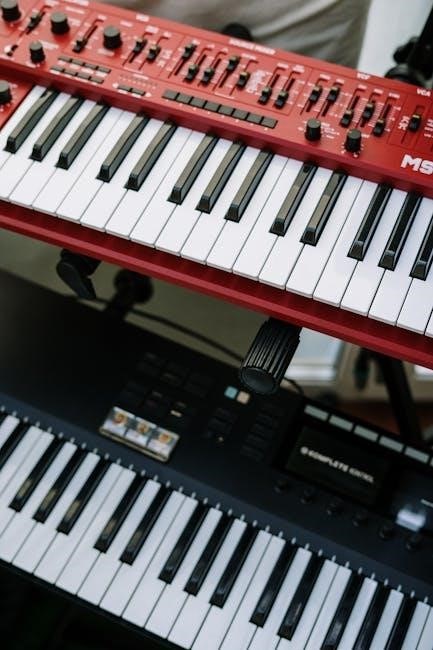
ishkur’s guide to electronic music
Ishkur’s Guide to Electronic Music is an interactive online resource created by Kenneth John Taylor, mapping the evolution of electronic music genres with detailed sound samples.
1.1 Overview of the Guide
Ishkur’s Guide to Electronic Music is an interactive map of electronic music genres, offering 153 subgenres and 818 sound samples. It provides a comprehensive exploration of electronic music’s evolution, from early experimental sounds to modern subgenres. The guide features a timeline, flowchart, and detailed descriptions, making it a valuable resource for both newcomers and enthusiasts. Its interactive design allows users to explore genres, their origins, and influences, fostering a deeper understanding and appreciation of electronic music’s diverse landscape.
1.2 Purpose and Significance
Kenneth John Taylor, aka Ishkur, created the guide to educate and entertain by mapping electronic music’s vast landscape. It serves as a roadmap for understanding genres, their origins, and interconnections. By providing sound samples and detailed descriptions, the guide demystifies the complexity of electronic music, making it accessible to newcomers while offering depth for enthusiasts. Its significance lies in its role as a historical and educational tool, preserving the evolution of electronic music and fostering discovery across its diverse spectrum.

History of Ishkur’s Guide
Created in 2000 by Kenneth John Taylor, the guide began as a Flash-based project, evolving through versions and platforms, becoming a cornerstone of electronic music education.
2.1 Creation and Early Versions
Created in 1999 by Kenneth John Taylor, Ishkur’s Guide began as a response to the proliferation of electronic music microgenres. The first version, released in 2000, was a simple Flash-based website hosted on platforms like Newgrounds and Digitally Imported. It gained popularity for its interactive approach, mapping genres and providing sound samples. Early versions were praised for their educational value, becoming a cult classic among electronic music enthusiasts and laying the foundation for its evolution into a comprehensive resource.
2.2 Evolution Over the Years
Over the years, Ishkur’s Guide transitioned from early Flash-based versions to more modern platforms. The guide was updated in 2021, introducing a new interface and expanded content. It now features interactive timelines, genre flowcharts, and sound samples, enhancing user exploration. Regular updates ensure the guide stays relevant, reflecting the dynamic nature of electronic music and its subgenres, while maintaining its core educational purpose and interactive appeal for both newcomers and seasoned enthusiasts alike.

Structure and Features of the Guide
Ishkur’s Guide features an interactive timeline, genre flowchart, and sound samples, providing a comprehensive exploration of electronic music’s history and diverse subgenres with detailed sound samples for enhanced understanding.
3.1 Interactive Timeline
The interactive timeline in Ishkur’s Guide offers a visual journey through electronic music’s history, allowing users to zoom in on specific decades and explore genres chronologically. It traces the evolution from early 20th-century experimental roots to modern subgenres, providing a seamless way to understand how different styles emerged and influenced one another. This feature is both educational and engaging, making it easier for fans to discover the historical context behind their favorite genres and artists.
3.2 Genre Flowchart
The genre flowchart in Ishkur’s Guide is a detailed visual map that diagrams the relationships between over 153 electronic music subgenres. Using a colorful, intricate design, it traces how genres branch out, influence one another, and evolve over time. Users can explore lesser-known styles, like terrorcore, alongside popular genres such as house and techno. This feature serves as a comprehensive tool for understanding the interconnectedness of electronic music, making it both educational and engaging for fans of all levels.
3.3 Sound Samples and Descriptions
Ishkur’s Guide features 818 sound samples, each representing a specific electronic music subgenre. These audio clips, often short and indicative, provide listeners with a tangible reference point for understanding the unique characteristics of each style. Accompanying descriptions detail the historical context, sonic elements, and cultural significance of the genres, making the guide both educational and immersive. This combination of sound and text allows users to explore and appreciate the diversity of electronic music with unparalleled depth and clarity.

Key Genres Covered in the Guide
The guide explores a vast array of electronic music genres, including House, Techno, Trance, Drum and Bass, and Ambient, offering insights into their origins and evolutions.
4.1 House Music
House Music, originating in 1980s Chicago, is a cornerstone of electronic music. Ishkur’s Guide explores its evolution from disco and funk roots to modern subgenres. The guide features sound samples and detailed descriptions, highlighting House Music’s rhythmic and groovy essence, making it a vital resource for understanding this influential genre.
4.2 Techno
Techno, originating in Detroit, is a pivotal genre in electronic music. Ishkur’s Guide delves into its roots, influenced by Kraftwerk and futuristic themes. Characterized by its minimalist, mechanical sound, Techno is explored in depth, with the guide mapping its evolution and subgenres. The resource provides sound samples and detailed descriptions, offering insights into Techno’s significance and its role in shaping modern electronic music culture.
4.3 Trance
Trance emerged in the 1990s, characterized by euphoric melodies, repetitive rhythms, and hypnotic beats. Ishkur’s Guide explores its evolution, from early Goa Trance to modern subgenres. The guide highlights its emotional depth and atmospheric textures, with sound samples showcasing iconic tracks. Trance’s influence on electronic music is detailed, tracing its roots in European clubs and its global popularity. The section provides a comprehensive overview, making it a vital resource for understanding Trance’s role in electronic music culture.
4.4 Drum and Bass
Drum and Bass, emerging in the mid-1990s, combines breakbeat rhythms with heavy basslines, influenced by jungle and jazz. Originating from the UK rave scene, it evolved into a distinct genre with complex drum patterns. Ishkur’s Guide explores its subgenres like liquid funk and neurofunk, illustrating its cultural impact and lasting influence on electronic music.

4.5 Ambient
Ambient music emphasizes calm, atmospheric soundscapes, often used for background listening. Originating in the 1970s, it was popularized by artists like Brian Eno, blending minimalism with electronic textures. Ishkur’s Guide explores its evolution, from experimental roots to modern subgenres like dark ambient, showcasing its versatility and influence on electronic music culture.

Impact on Electronic Music Culture
Ishkur’s Guide has profoundly shaped electronic music culture by educating listeners, sparking curiosity, and becoming a beloved cultural artifact, bridging genres and inspiring musical exploration globally.
5.1 Education and Awareness
Ishkur’s Guide has become a vital educational tool, offering an interactive exploration of electronic music’s history and diversity. It provides detailed timelines, genre flowcharts, and sound samples, enabling users to discover obscure subgenres and understand their origins. The guide demystifies complex relationships between styles, fostering a deeper appreciation for electronic music’s evolution. Its accessibility has made it a cornerstone for both newcomers and enthusiasts, promoting a comprehensive understanding of the genre’s rich cultural and musical heritage.

5.2 Influence on Music Discovery
Ishkur’s Guide has revolutionized music discovery by providing an interactive map of genres, allowing users to explore lesser-known styles and trace their origins. The guide’s detailed sound samples and flowcharts enable listeners to uncover new artists and tracks, fostering a deeper connection to electronic music. Its influence extends beyond education, inspiring curiosity and encouraging fans to venture into uncharted musical territories, making it a cornerstone for both casual listeners and dedicated enthusiasts alike.
Reception and Legacy
Ishkur’s Guide is a cult classic, educating and inspiring generations of electronic music fans. Its interactive design and comprehensive coverage have made it a legendary resource, despite some criticism of its tone and genre opinions.

6.1 User Feedback and Reviews
Users praise Ishkur’s Guide for its educational value and interactive design, calling it a “cult classic” that has shaped electronic music knowledge. Many appreciate its detailed genre breakdowns and sound samples, which have helped fans discover new styles. However, some critics find the tone dismissive of certain genres. Despite this, the guide remains a beloved resource, with fans nostalgically remembering its Flash-era quirks and praising its ability to spark curiosity and debate within the electronic music community.
6.2 Cultural Significance
Ishkur’s Guide holds a pivotal place in electronic music culture, serving as a foundational tool for understanding genre evolution. Its influence spans generations, with many artists and fans crediting it for their musical education. The guide’s interactive nature and comprehensive scope have solidified its legacy as a cultural artifact, bridging the gap between historical context and modern exploration. Its impact is undeniable, making it a cornerstone of electronic music’s shared knowledge and appreciation.

The Future of Ishkur’s Guide
The guide continues to evolve, inspiring new generations of electronic music enthusiasts. Its legacy ensures it remains a vital resource for exploring and understanding the genre’s diversity.
7.1 Updates and New Features

Recent updates to Ishkur’s Guide have introduced enhanced interactive features, including improved genre navigation and expanded sound samples. New visual elements, such as updated timelines and flowcharts, offer a more immersive experience. The guide now incorporates user feedback, adding lesser-known subgenres and refining descriptions for clarity. These updates ensure the guide remains a dynamic and essential tool for exploring electronic music’s vast landscape, catering to both newcomers and seasoned enthusiasts alike.